When we say, ‘hair miniaturization‘, are we literally speaking about tiny hair? Not exactly. But if you’re one of the people living with the condition, you’ve probably heard the term. Or maybe not.
You see, although there are hundreds of millions of people around the world dealing with visible hair loss, there’s also a considerable number of people who aren’t aware it’s even happening.
What is Hair Miniaturization?

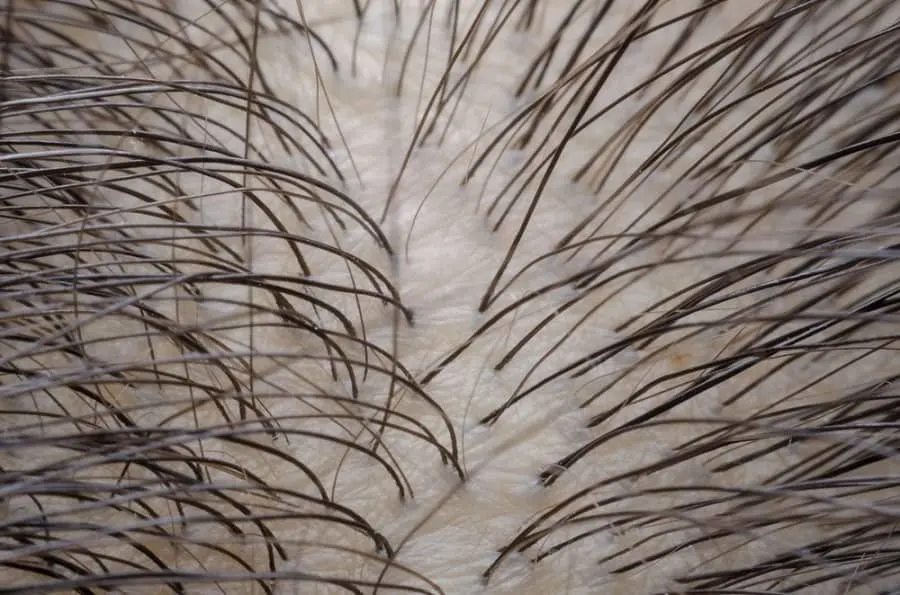
Hair miniaturization is a biological process (also known as “balding”), usually driven by genetics and hormones, in which scalp hairs shrink in size over time. The condition begins in the hair follicles, some of which are genetically susceptible to dihydrotestosterone (DHT).
This sex hormone contributes to adult male characteristics such as a deeper voice, muscle mass, and the growth of body hair. It also causes the anagen hair growth phase on the scalp to become progressively shorter.
Because the anagen hair growth cycle is shorter, the individual hairs (usually from one to four) in the follicles don’t have time to grow and mature to full size. And that’s where the term “hair miniaturization” comes in; as the hairs decrease in length and diameter, they eventually disappear, resulting in baldness and thinning in those areas.
Hair Miniaturization Doesn’t Happen Everywhere to Everyone
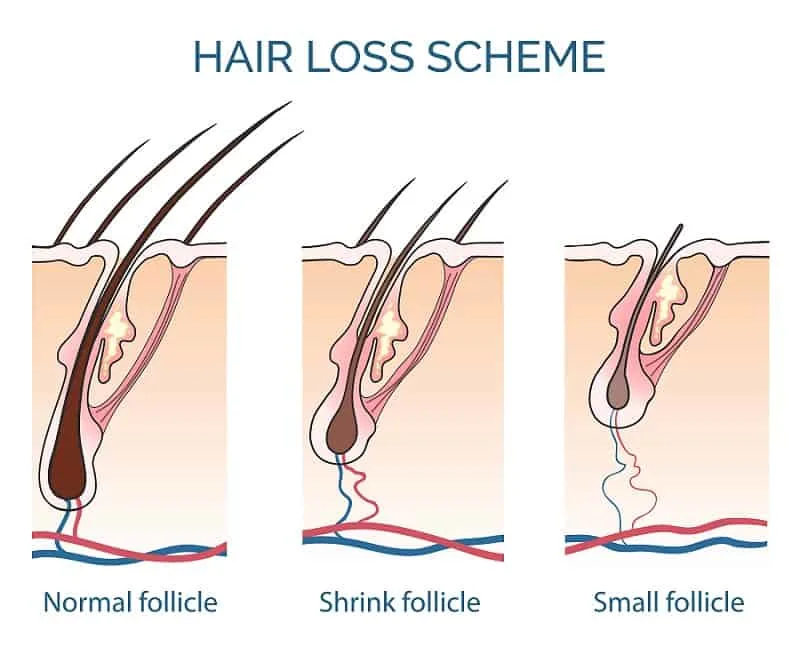
In many people, the hair follicles in some regions of the scalp (typically the back and sides) are not affected by the DHT hormone, so the person will likely never experience hair loss or hair miniaturization in those areas. This configuration of hair loss is commonly known as “male pattern baldness” because it tends to affect mostly men.
Women also experience hair loss, typically appearing as a general thinning across the top of the head and down the part-line. The symptoms are usually milder because women produce lower levels of the enzyme 5a-reductase that converts testosterone into DHT.
Women also produce another enzyme, aromatase, which is present in high levels in the front and rear hair follicles of the scalp, which is why they tend not to lose hair in these regions.
How to Check for Hair Miniaturization
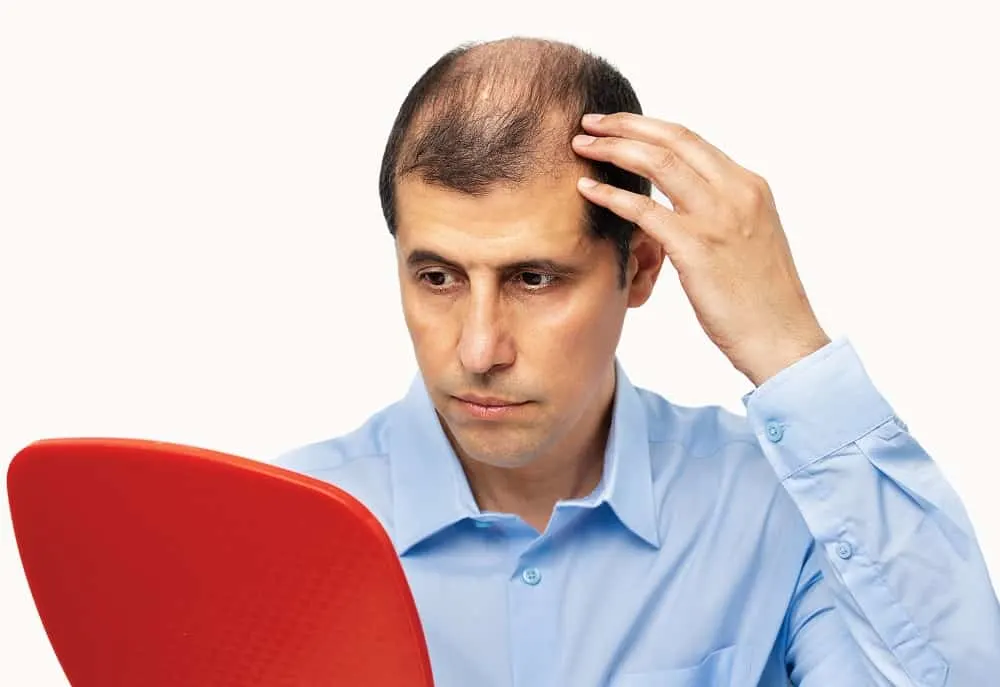
It is easy to look for visual signs of hair miniaturization. One of the most obvious signs is a receding hairline. If your hairline is looking increasingly like an “M” shape, you may be seeing the hair follicles in the front of your head dying.
You can also use a mirror to check the top and back of your head for thinning hair. If you can see more scalp than you used to, your hair is likely thinning.
Finally, you can monitor hair loss when showering and brushing your hair. The average person can lose around a hundred hair strands a day, so some hair loss is normal. However, if you are losing large chunks of hair at a time, this may be a sign of hair miniaturization.
If you have concerns about thinning hair, you have a few ways of confirming your suspicions. A dermatologist may choose to rate your hair on the Norwood Scale, a system for tracking male pattern baldness.
Your doctor could also try a hair pulling test, or you could perform one on your own. By taking a section of hair and gripping it at the roots and ends, you can gently tug on your hair to see how many strands fall off. If it’s more than a few hair strands, you may be experiencing hair miniaturization.
If you aren’t sure what’s causing your hair miniaturization, it is a good idea to consult a doctor. Your doctor may want to run blood tests to check for any underlying medical conditions.
9 Signs and Symptoms of Hair Miniaturization
- Your hair is falling out more than usual.
The average rate of hair loss is about 100 per day; anything more could be problematic. - Receding hairline.
Hair is thinning in the temple area, creating an M shape on your forehead. - The hair on the crown is thinning.
A light bald spot is forming in the crown area. - Hair seems thinner overall.
You seem to be seeing more of your scalp than before. - You notice it in photos.
Pictures tell the story. Compare the old ones with new ones. - People are mentioning it.
Are your friends and family telling you you’d look better if you shaved it all off? - Hair seems to take longer to grow.
As the anagen growth cycle shortens, hair takes longer to grow. - Your barber or hairdresser mentions it.
A trained professional will likely notice the signs before you do. - Itchy scalp.
The more you scratch, the more hair will fall out. Cure the itch, save some hair!
Can You Reverse Your Hair Miniaturization?
Whether you can reverse your hair miniaturization depends on how progressed the miniaturization is. If you catch the condition early enough, you can take steps to try to reverse the constriction of the hair follicle. However, if the muscle connecting the follicle to stem cells falls out, the hair follicle has died and cannot be brought back.
How to Reverse Hair Miniaturization

You can try to reverse hair miniaturization with both medicine and natural remedies. The most popular medication for hair loss is minoxidil, also known as Rogaine. People who use this medication have seen a reversal in their hair loss. However, some users have found that they have to continue using it, or the hair loss will return.
Other medical options include laser treatments, micro-needling, hair transplants, and various prescription medications.
You can also focus on natural remedies and treatments. If you are in the early phases of hair miniaturization, remember to regularly massage your scalp, as this will stimulate hair follicles.
Rosemary oil kills germs and improves scalp health, so if a scalp condition is causing hair loss, this option can be quite effective. Another alternative is to increase the biotin in your hair by consuming biotin-rich foods and using hair products that have this vitamin as a key ingredient. Biotin is essential for healthy hair, and deficiencies can cause thinning hair.
Solutions for Hair Miniaturization
Before you decide to take extreme measures to resolve hair miniaturization, such as hair transplant surgery, start with less invasive options to see how they work.
Topical Medications
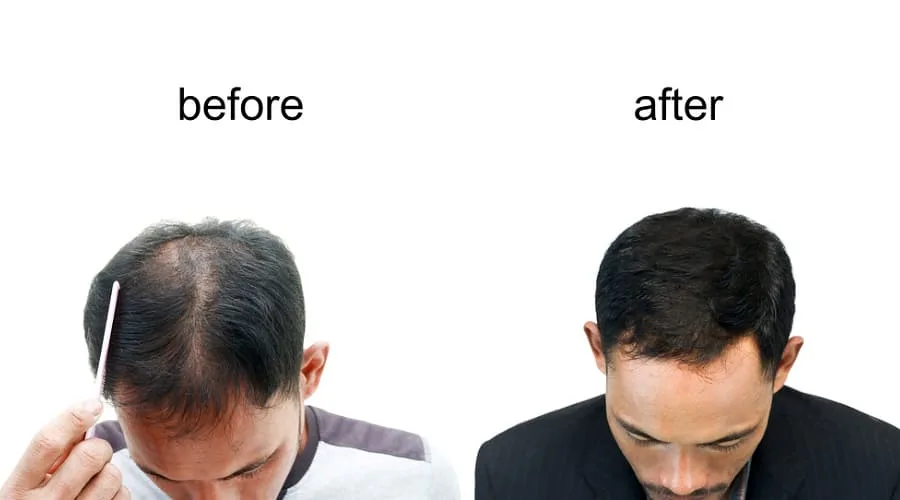
Applying a combination of Finasteride and Minoxidil 5% to the affected areas of the scalp can slow down and reverse hair miniaturization, especially at the beginning stages of hair loss. These two medications can also have a positive impact on the thickness and volume of the hair.
Finasteride works by preventing testosterone from converting into DHT in regions under the scalp and surrounding the hair follicles. Reduced DHT prevents balding and helps to elongate the anagen hair growth cycle.
Minoxidil 5% helps to eliminate blockages to the scalp’s pores, such as excess oil, dead skin, and dust. Its antiseptic formulation penetrates deep into the hair follicles, killing bacteria, improving blood circulation, and reducing DHT levels.
DHT-blocking shampoos for hair miniaturization offer lower doses of these two medications combined, which may also be useful in disrupting the effects of DHT on the hair follicles of some individuals.
Low-Level Laser Therapy (LLLT)
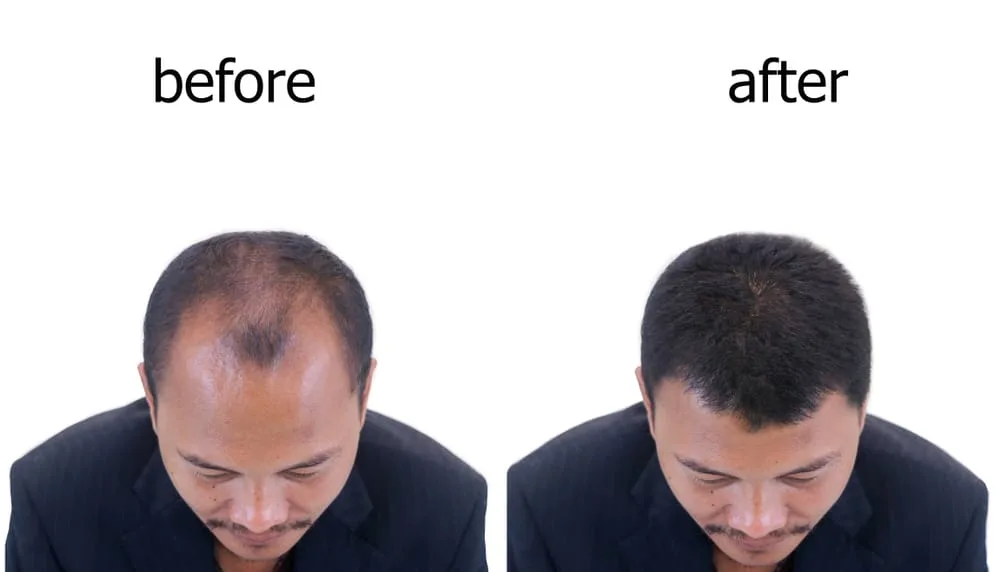
Modern technology has an “electrifying” solution to the problem of hair miniaturization, and the FDA has cleared it: Low-Level Laser Therapy.
LLLT devices come in wand or cap form and emit a continuous red LED light, which is said to increase blood circulation in the hair follicles while reducing inflammation.
The combination of these two processes is believed to stimulate the epidermal cells around the hair follicle bulge, which promotes the hair to move into the anagen growth phase more quickly.
Vitamins and Minerals to Stop Hair Miniaturization

Many vitamin and supplement companies claim to have products that promote hair growth and slow down hair miniaturization, but few of these claims can be scientifically proven.
One interesting observation researchers have noted is that individuals who are deficient in vitamin D or iron can help restore hair loss brought on by stress, shock, or trauma by adding these supplements to their daily regimen.
If you are experiencing hair miniaturization, it couldn’t hurt to have your doctor check out your vitamin D and iron levels. Even if it doesn’t help with hair loss, knowing your levels can help you avoid other illnesses such as cancer and anemia.
Hair Miniaturization Vs Regrowth
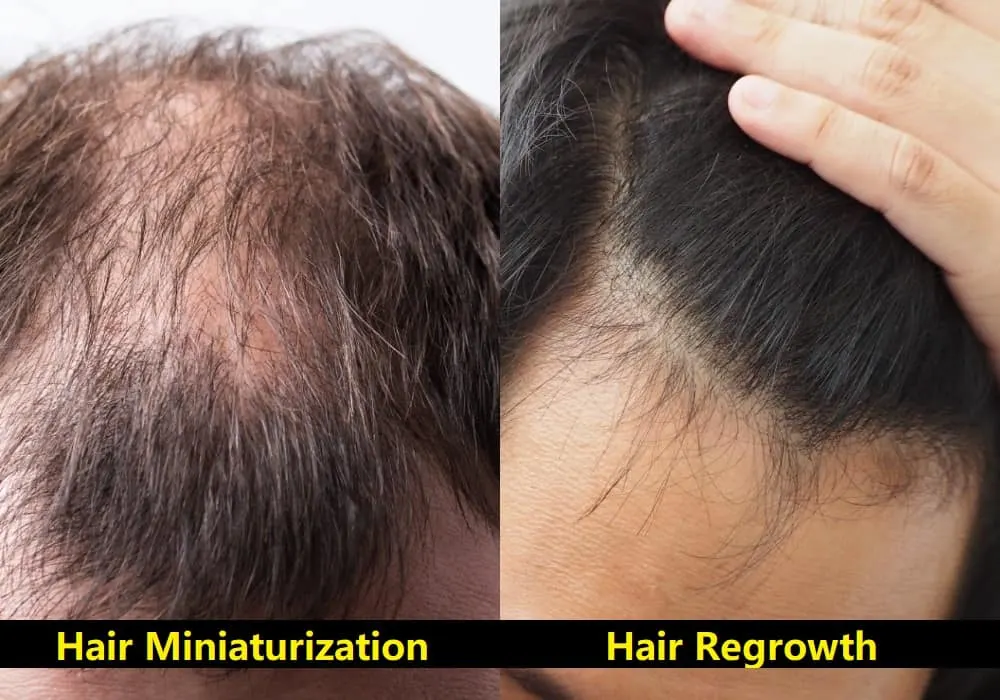
It can be challenging to tell whether you’re experiencing hair miniaturization or hair regrowth. In the case that you recently shaved a portion of your head or you’ve experienced temporary hair loss from medication or scalp irritation, you are probably anxious for the hair to regrow.
Since hair only grows about half an inch every month, you will likely experience a period of regrowth where it’s hard to tell if the hair is thinning or growing back. New baby hairs will be short and soft. If you have dark hair, you can also check for small dark spots or shadows that indicate active hair follicles.
Short hairs aren’t necessarily a sign of breakage. To confirm breakage, you’ll need to look at the health of the hair strand. Unlike new baby hairs, broken hairs will be dry, brittle, and have split ends. Additionally, if you are balding, you will see fewer spots or shadows on your scalp since your hair follicles are closing up.
FAQs
Here are answers to some of the most frequently asked questions about hair miniaturization.
No, hair miniaturization does not necessarily mean you are going bald. It refers to the condition of hair follicles constricting and possibly dying, but depending on the cause, it may not lead to full baldness.
In some cases, miniaturization causes the hair to become much thinner but doesn’t affect every single hair follicle on the head. In other instances, this condition is related to hormonal changes from aging, especially male hormonal changes, and will lead to significant thinning or baldness.
Yes, you can stop the process if you treat it early enough. Reversing hair loss is usually a matter of timing, as once the follicle has constricted too much, it will no longer work and can’t be brought back.
If you want to stop it, you will need to identify the cause of your condition. It’s a good idea to make an appointment with a dermatologist who specializes in hair and scalp health, so they can advise you on the best course of treatment.
If your hair miniaturization is related to hormonal male pattern baldness, it can take many years for an area of your head to become completely bald. The process varies for each individual depending on their genetics, body chemistry, and environmental factors.
Most people will experience several years of thinning hair before their entire head of hair is miniaturized. Generally, the average timespan for male pattern baldness is five to fifteen years.
On the other hand, if your hair miniaturization isn’t related to male pattern baldness, your experience might be quite different. Many medical conditions can cause hair to miniaturize, and the nature of your particular situation will impact the speed of the process. You should consult your doctor to figure out what is causing this condition and how quickly it’s progressing.
Having up to 20% of your hair follicles in a miniaturization state is considered normal. Each of your follicles goes through a lifecycle, including a resting phase. During the resting phase, your hair will naturally fall out, and the hair follicle will remain inactive for a little over a month.
A resting hair follicle is not the same as irreversible hair miniaturization. The follicle is still healthy and functional and will continue to grow hair once the rest period is over.
If the hair that falls from your head has a little white bulb on the end, this is a good indicator that the hair has fallen naturally from the scalp and hasn’t broken off from being too thin or fragile.
If more than 20% of your hair appears to be in a resting phase, and the hair is getting thinner instead of growing back, you may have a more significant hair loss problem.
It is permanent once the follicle fully dies. A constricting follicle can be treated and reversed if caught early enough. But if it constricts to the point that the tiny muscle attached falls out, and no hair can grow, the follicle is permanently dead and cannot be revived.
Hair miniaturization doesn’t have to be a distressing or depressing experience. If you notice that the quality of your life is being affected negatively, then embark on a journey to solve the problem. These non-invasive, non-surgical alternatives for hair miniaturization might be the key to success in overcoming the condition.
